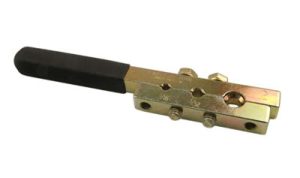
When installing or replacing cables in an airplane, you may want to use a swaging tool. As their name suggests, swaging tools are designed for swaging. While crimping tools are designed for crimping, swaging tools are designed for crimping.
The Basics of Swaging Tools
A swaging tool is a handheld tool — it resembles a pair of pliers — that’s used to compress cable sleeves. The cable sleeves with which they are used are known as swage sleeves. You can install swage sleeves around cables by using a swaging tool. As the swaging tool clamps down, it will compress the swage sleeve so that it stays on the cable.
How Swaging Tools Work
To use a swaging tool, you’ll need to first place the swage sleeve around the cable. After moving the swage sleeve to the appropriate location, you can place the swaging tool around it.
Most swaging tools support swage sleeves in a variety of sizes. You’ll need to place the swage sleeve in the appropriate hole based on its size. The photo above, for instance, shows a swaging tool that supports three sizes.
Squeezing the handle of the swaging tool will compress the swage sleeve. The swage sleeve will deform while subsequently wrapping around the cable. You can then release and remove the swaging tool.
Swaging vs Crimping
The terms “swaging” and “crimping” are often used interchangeably. While similar, though, they refer to different processes. Before buying a swaging tool, you may want to familiarize yourself with the difference between swaging and crimping.
Swaging will completely compress and deform the swage sleeve around the cable. Crimping, on the other hand, will only compress the edges of a sleeve or ferrule around the cable.
Swaging and crimping will both add a sleeve or ferrule around the cable. Only swaging, however, will completely compress and deform it.
Choosing a Swaging Tool: What You Should Know
When shopping for a swaging tool, you should check to see what material it’s made of. Swaging tools made of steel are typically stronger than those made of aluminum.
You should also consider the supported sizes when shopping for a swaging tool. Different swaging tools support different swaging sizes. Common swaging sizes include 1/16, 1/32 and 1/8.
In Conclusion
Swaging tools are commonly used in the aerospace industry. Airplanes require cables. To install swage sleeves on these cables, you’ll need a swaging tool. Swaging tools are handheld tools that you can use to install swage sleeves on cables.



